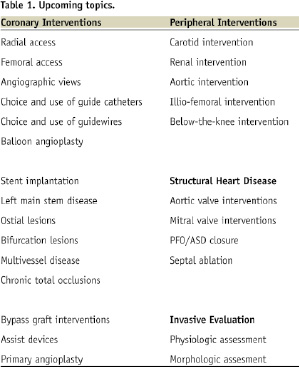The history of interventional cardiovascular medicine is a history of visionaries and pioneers, of true believers and hard working scientists. The distinct starting point remains unclear; however, we know that already in the 19th century “cardiac catheterisation” was performed by the French physiologist Bernard to record intracardiac pressure in animals1.
The first cardiac catheterisation in man took place in 1929 in Eberswald, Germany, when Werner Forssmann, a young surgical resident, inserted a catheter in his antecubital vein and, proceeded to an x-ray room where he documented the catheter’s position in his right atrium2.
In 1958, while conducting an aortic root angiography, Mason Sones, a paediatric cardiologist at The Cleveland Clinic (Cleveland, OH, USA), discovered that the catheter had accidentally entered the patient’s right coronary artery and, before it could be removed, 30cc’s of contrast dye had been released. It was the great achievement of Sones to take the next step, developing from this serendipitous event, the concept of selective coronary angiography3.
The progression to percutaneous intervention was not too far behind, when in 1964, Charles Dotter used multiple catheters of increasing diameter to open blocked arteries to improve blood flow in patients with peripheral arteriosclerosis4. Dotter’s techniques of transluminal angioplasty were subsequently built upon by Andreas Gruentzig, a young German physician working at University Hospital in Zurich, Switzerland, who developed a double-lumen catheter fitted with a polyvinylchloride balloon in 1975. In September 1977 Gruentzig finally performed the first coronary angioplasty in humans5.
Following the seminal work by Gruentzig, there were rapid technical advances. Soon to follow was the development of over-the-wire coaxial balloons, brachial guide catheters, steerable guidewires and coronary atherectomy devices. This finally culminated in the first-in-man implantation of a coronary Wallstent by Jacques Puel in 1986, in Toulouse, France6.
Since then, active devices such as intracoronary radiation therapy, drug eluting stents7, biodegradable stents, and, most recently, drug eluting balloons, which, together with contemporary antiplatelet therapy, have been developed to mitigate the most important complication following percutaneous angioplasty and stent implantation: the mechanism of restenosis.
More recently, in the era of evidence-driven PCI, the need to obtain objective evidence for PCI has led to the development of more sophisticated intracoronary evaluation devices such as Doppler flow and pressure wires, intravascular ultrasound, virtual histology, thermography, and optical coherence tomography.
This technical progress has been largely driven by the exponential rise in the number of coronary interventions worldwide, which have now reached a volume of more than a million procedures per year, addressing a broad range of elective and emergency indications. Percutaneous interventions have become the standard of care for acute coronary syndromes and large scale initiatives such as the “Stent-for-Life” campaign of the European Association of Percutaneous Cardiovascular Interventions (EAPCI) have been created to address persisting regional differences in the availability of primary percutaneous interventions for acute ST elevation myocardial infarction8.
Similarly, non-coronary interventions have developed exponentially in recent years: carotid intervention, peripheral limb and renal angioplasty, aortic stent grafting, septal occluders for patent foramen ovale and atrial septal defects, as well as the recent advent of the percutaneous treatment of heart valve disease.
In addition to these contributions made by pioneers and scientists, the story of the broad success of percutaneous intervention is also a story of teachers and students; of experienced colleagues transmitting their knowledge to younger colleagues. In clinical practice these learning experiences usually start with earnest observation, followed by guided, stepwise hands-on training and progressing to active, knowledge-based debate on the appropriate strategy for each individual patient.
The knowledge transfer from an experienced expert to a younger colleague is usually done in a direct face-to-face fashion, and, thus, is limited to a few students only. Newer conference concepts with ‘live’ case presentations or recorded cases have, however, proven to be an effective tool to spread expert knowledge beyond exclusive circles. Furthermore, several excellent books have been published on the scientific basis of cardiovascular interventions and on detailed, mainly text-based, explanations of cardiovascular intervention.
It is however, astonishing, that none of this material has focused on a simple and very effective step-by-step teaching approach on the technical issues and the management of complications in percutaneous cardiovascular intervention. This stepwise approach, with the utilisation of modern on-line multimedia tools, would effectively mimic the traditional face-to-face style, and would appeal to a broad audience.
To fill this gap, the editorial board of EuroIntervention has decided to
introduce an exciting new educational series on percutaneous cardiovascular intervention. It will be comprised of educational articles, in line with conventional European practice, covering basic and advanced interventional and diagnostic techniques published in each of the following issues of EuroIntervention. Allied to the educational arm of EuroPCR, it will offer, as well as the print edition, interactive, on-line learning and communication.
The chapters are written with the intention of providing a clear practical, step-by-step teaching source and reference for cardiovascular intervention. The emphasis is very much on a practical approach and the complete work will encompass all the major cardiovascular procedures: coronary and peripheral intervention; structural heart disease and invasive imaging.
First in this series, will be the challenging treatment of ostial coronary artery disease to be published in the next issue of EuroIntervention. Each topic will be introduced by a brief summary in the journal with a link to the appropriate chapter with dynamic images being available at the EuroIntervention and EuroPCR websites (for an overview of the planned topics see Table 1).

One of the most important aspects of the new series is interactivity. The online site will provide the opportunity for comments, suggestions, words of caution, and case submissions highlighting specific problems or new solutions for a particular topic. We hope that given this interactive forum, there will be a considerable exchange of ideas and personal experience, achieving a comprehensive and practical guide to current practice in percutaneous cardiovascular interventions.
We look forward to meeting you at www.eurointervention.org and www.europcr.com!

